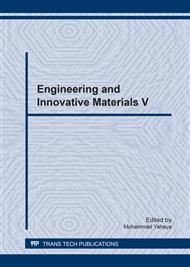p.25
p.30
p.36
p.45
p.51
p.56
p.65
p.71
p.75
Optimum Injection Moulding Processing Condition to Reduce Shrinkage and Warpage for Polypropylene-Nanoclay-Bamboo Fibre with Compatibilizer
Abstract:
The purpose of this research is to optimise the processing condition of injection moulding towards samples made from polypropylene-nanoclay-bamboo fibre with compatibilizer. The defects that have been controlled upon the optimisation were shrinkage and warpage. The selection of injection moulding processing condition was packing pressure, melt temperature, screw speed and filling time. The research started by drying the bamboo fibres at 120°C. Then, the 1 wt. % fibres were mixed with 79 wt. % of polypropylene, 15 wt. % of compatibilizer and 5 wt. % of nanoclay. The mixing process was performed by using Brabender Plastograph machine. After that, pallets were produced by using Plastic Granulator machine for injection moulding process. The optimisation process was accomplished by adopting the Taguchi method. According to the results, the value of warpage defect between compounding for 1 wt. % fibre and without fibre content was not significant. However the optimum setting of 170°C melt temperature, 35% packing pressure, 30% screw speed and 2 seconds filling time can significantly reduce shrinkage. In conclusion, the optimum processing condition of polypropylene-nanoclay, fibre bamboo had been achieved, and the existence of fibre obviously giving a promising manufacturing opportunity to improve the quality of the injected moulding products.
Info:
Periodical:
Pages:
51-55
Citation:
Online since:
March 2017
Price:
Сopyright:
© 2017 Trans Tech Publications Ltd. All Rights Reserved
Share:
Citation:


